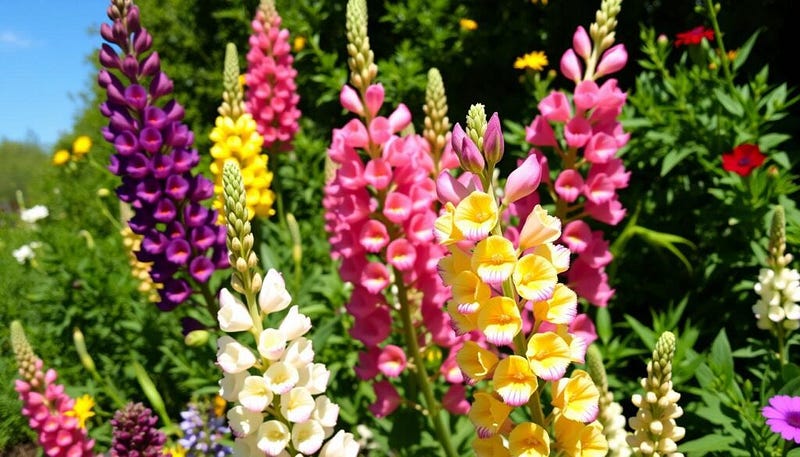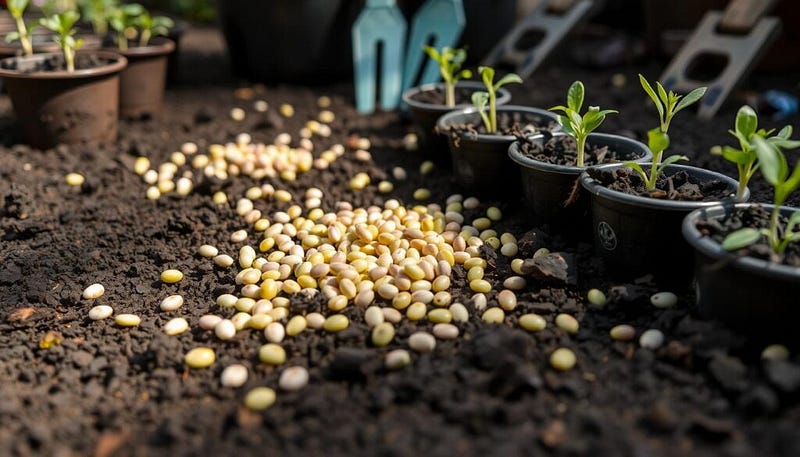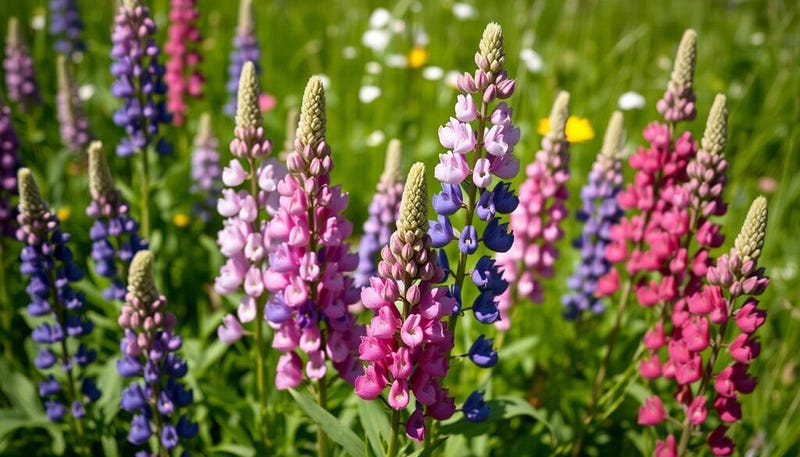Lupine: How to Grow and Care for These Colorful Blooms

Are you fascinated by the stunning spikes of lupine flowers? These vibrant blooms paint the landscape in a variety of colors. Growing lupines can be a joy, but do you know the secrets to success? Let’s dive into the world of lupines and learn how to grow and care for these beautiful flowers.
Key Takeaways
- Lupines are annuals or short-lived perennials with a lifespan of 2–5 years.
- They thrive in USDA hardiness zones 4–8, requiring at least 6 hours of full sun daily.
- Lupines bloom from late spring to midsummer, producing a variety of flower colors.
- Lupine plants are deer-resistant and beneficial to pollinators, but are toxic to humans and animals.
- Proper soil preparation, watering, and propagation methods are key to successful lupine cultivation.
What is Lupine?
Lupine, also known as lupin or bluebonnet, is a part of the pea family (Fabaceae). It has showy, tall spikes of colorful flowers. This perennial or annual plant grows 3–4 feet tall and 1–1.5 feet wide. Its botanical name is Lupinus x hybrida, a mix of native lupine species.
Common Names and Botanical Details
Lupines are from North America and are known by many names like lupine, lupin, and bluebonnet. The Lupinus genus has over 199 species. These plants can be herbaceous perennials or shrubs up to 3 meters tall.
The taxonomy of lupines is complex. Estimates say there are between 200 and 500 species worldwide.
“The term ‘lupine’ comes from the Latin word ‘wolf’ (lupus), reflecting the wolfish characteristics of lupine groups.”
Lupine seeds are used for green manure, fodder, and as food. They are also grown as ornamental flowers. Their vibrant blooms come in colors like blue, purple, white, and yellow.
Lupine Flower Colors and Hardiness Zones
Lupine flowers are known for their bright and varied colors. They can be white, pink, red, yellow, blue, or purple. Some even have bicolor or multicolor petals, making them even more beautiful.
Lupines also have a lovely scent and bloom in spring and summer. They can start blooming as early as April or as late as August. This means they add beauty to your garden for a long time.
Lupines grow well in USDA Hardiness Zones 4–8. But, some types can be grown as annuals in warmer places or as perennials in colder areas. It’s important to pick lupine varieties that fit your local climate for the best results.
There’s a lupine for every garden and taste. They come in classic blues, vibrant reds, and soft pastels. With their colors, scent, and hardiness, they’re a must-have for flower lovers.

Growing Lupine From Seed
Lupines are beautiful flowers that can brighten up your garden. They’re easy to grow from seed, but it might take up to two years for them to bloom. To grow lupines successfully, follow a few key steps for starting and transplanting seeds.
Seed Starting and Transplanting Tips
Lupine seeds have a hard outer layer that needs to be nicked or soaked for germination. Plant them about 1/4 inch deep in soil that drains well. They should sprout in 14–30 days.
But, lupines don’t transplant well because of their long taproots. It’s best to plant them directly in their garden spot.
If you want to pot up lupine seedlings first, that’s okay too. Just pot them up in the spring before moving them outside. This helps them develop a strong root system before transplanting.

Whether you start them in pots or directly in the garden, be patient. Lupines may take a year to bloom fully. With care and patience, you’ll enjoy their vibrant colors in your garden.
Planting and Site Selection
When growing lupines, choosing the right spot is crucial. They love full sun, needing at least six hours of direct sunlight each day. They thrive in loose, well-draining soil that’s slightly acidic. But they can also handle more neutral or slightly alkaline conditions.
Before planting, adding compost to heavy clay soils can help. It improves drainage and creates a perfect spot for these colorful flowers.
It’s also important to space lupine plants correctly. Depending on the type, they should be 1–3 feet apart. This allows for good air circulation and growth. It also prevents problems like powdery mildew and lets the plants reach their full height.
By picking the right spot and planting lupines correctly, gardeners can make them thrive. Whether starting with seeds or transplanting, remember their sun, soil, and spacing needs. This ensures they bring vibrant color and interest to your garden.

Watering and Fertilizing Lupine
Moisture and Nutrient Needs
Watering and fertilizing lupine plants right is key for their growth. They like moist, well-draining soil, especially when they’re new. Once they’re settled, they only need extra water when it’s dry.
They can fix nitrogen from the air, so they don’t need a lot of fertilizer. But, a light fertilizer that’s rich in phosphorus helps in alkaline soils. A balanced fertilizer like 2–6–4 is best for their flowers. Organic fertilizers give slow, steady food, while synthetic ones work fast.
New lupines need about 1 inch of water a week to grow strong roots. Spread this water over 2–3 days to help roots grow deep. As they get older, they need less water, especially in the fall. Plants in pots need more water, especially when it’s hot and dry.

“Less can be more when it comes to fertilizer, and it is essential to calculate the correct dosage to avoid over-fertilization.”
By following these tips for lupine watering and lupine fertilizer, your plants will flourish. Knowing about lupine soil pH and lupine nitrogen fixation helps too. This way, your garden will be a beautiful sight to see.
Lupine Varieties and Hybrids
Lupines are part of a big family with 200 to 600 species. They are diverse and useful in gardens. Many garden lupines come from the native Lupinus polyphyllus. But, breeders have made many hybrids and cultivars with different colors and shapes.
The Russell Lupine mix is famous for its tall spikes of flowers. They grow 3–4 feet tall and come in many colors. The Gallery Lupine Hybrids are smaller, reaching only 1–1.5 feet wide.
Other notable types include the white lupine (Lupinus albus), silver lupine (Lupinus albifrons), and blue lupine (Lupinus angustifolius). The original blue lupine is known for being very hardy and strong.
Lupines need soil that is moderately fertile and slightly acidic. They also like it moist but well-drained. They attract butterflies and hummingbirds with their bright flowers from late spring to mid-summer.

“Lupines are a true delight, offering a stunning array of colors and forms that can transform any garden into a living work of art.”
Caring for Lupine Plants
Pruning, Deadheading, and Overwintering
Keeping your lupine plants healthy is key for their beauty and growth. Start by removing spent flowers to get more blooms. After they stop flowering, cut back the leaves to the ground. This helps them save energy for next year.
When lupines sleep through winter, they need special care. Cut the stalks to 1–2 inches above the ground. Then, add mulch to keep the roots warm. Since lupines have deep roots, you don’t need to move them.

Lupine Propagation Methods
Lupines can be grown in many ways, each with its own benefits. You can use cuttings, self-seeding, or division to grow more plants. These methods make it easy to add more color to your garden.
Propagating Lupines from Cuttings
Starting new lupines from cuttings is a great choice. In early spring, pick healthy stems that are 4 to 6 inches long. Make sure they have at least two sets of leaves. Using rooting hormone powder can help them grow roots faster.
Lupine Division
Dividing lupine plants every 2–3 years can refresh your garden. But, it’s tricky because of their long taproot. Be gentle with the roots when you divide them. Do it in the spring for the best results.
Lupine Self-Seeding
Lupines easily spread by self-seeding. This means you can have more plants without much work. However, the new plants might not look exactly like the original, which can be fun.

Pests, Diseases, and Problems
Lupines can face many pests and diseases. These issues can harm their growth and look. Knowing about these problems helps keep your lupine plants healthy and beautiful.
Aphids and slugs/snails are common pests. They suck sap and can damage leaves and slow growth. It’s important to spot and remove them quickly.
Lupine anthracnose and powdery mildew are diseases that can harm lupines. Anthracnose often hits blue lupines and fungicides can help. Powdery mildew comes from too much water, so keep leaves dry.
Other diseases like brown spot disease, Sclerotinia stem rot, and mosaic viruses can also affect lupines. If a plant gets sick, remove and destroy it to stop the disease from spreading.
To keep lupines healthy, make sure air circulates well. Don’t overwater and deal with pests and diseases fast.

Lupines can spread quickly and take over gardens. They can also affect erosion in coastal areas. It’s important to manage them carefully and think about the local environment.
By knowing how to deal with lupine pests and diseases like lupine anthracnose and powdery mildew, gardeners can help their lupines grow well. This makes for a lively and healthy garden.
Lupine in the Garden
Lupines add a stunning touch to any garden. Their tall, vibrant spikes grab everyone’s attention. They’re great for borders, beds, and even as cut flowers, adding whimsy and elegance.
Pair lupines with plants like lavender, yarrow, and ornamental grasses for a beautiful garden. These plants not only look good together but also make your garden deer-resistant.
Lupines love well-drained, poor soils. They’re good for the soil because they fix nitrogen. Adding lupines to your garden makes it low-maintenance and attracts pollinators, boosting biodiversity.
Lupines bring beauty and benefits to any garden. They’re easy to care for and attract wildlife. By choosing the right plants to pair with them, you’ll have a stunning garden that’s easy to maintain.

Lupine Meaning and Uses
Lupines are not just pretty garden plants. They also carry deep meanings and are useful in many ways. In flower arrangements, their bright lupine blooms show imagination, happiness, and admiration. In Texas, the bluebonnet (Lupinus texensis) covers fields with its beauty.
Lupines can’t be eaten because they are toxic. But, lupine seeds were once used to make flour. They were also grown to stop soil erosion. Now, the lupine flower essence is sold, helping some people see things differently and feel better.
Symbolic Meanings and Floral Designs
The lupine’s symbolic meanings are as varied as its colors. These flowers are linked to:
- Imagination
- Happiness
- Admiration
Infloral designs, lupines bring a bold, whimsical feel. They fit many styles and colors. Their tall spikes are great for modern or romantic bouquets.

“A legend says lupines came from a girl’s kindness during a drought and famine in a tribe.”
Lupines may not be food, but they’re very important for the environment. As part of the nitrogen-fixing legume family, they make the soil better. They also help many animals, like the Karner blue butterfly, which eats only lupines.
Deer-Resistant and Pollinator-Friendly
Lupines are known for keeping deer away. They have toxic compounds that deer don’t like. This makes them great for gardens where deer are a problem.
Deer stay away from plants with fuzzy leaves and strong smells. Lupines fit this description perfectly.
Lupines are also a hit with pollinators. They attract bees, butterflies, and hummingbirds with their nectar. These plants and pollinators have worked together for centuries.
- Bees love the flowers of lupines, salvia, alyssum, and zinnias.
- Butterflies enjoy the big, bright flowers of lupines, delphiniums, and cosmos.
- Hummingbirds are drawn to the red flowers of lupines, columbine, and foxgloves.
Adding lupines and other plants to your garden helps both wildlife and your garden. These plants keep deer away and help pollinators. This is good for your garden’s health.

Lupine in Other Regions
Lupines are loved for their bright flowers, but they grow differently in various places. They do well in cool, northern areas with mild summers. But, they find it hard to grow in hot, humid places.
In cooler lupine zones, like the Pacific Northwest and parts of the northeastern U.S., lupines come back every year. But in warmer lupine climates, they need to be replanted every season.
Some native lupine species can be seen as invasive in certain areas. They might take over and crowd out other plants. But, the lupine hybrids grown for gardens are usually not seen as a problem. Lupines are native to North America and can be found growing wild in many parts of the continent, especially in the west.
“Lupines are a true testament to the diversity of plant life, thriving in a range of climates and landscapes across the globe.”
Whether you’re growing lupines in your garden or seeing them in the wild, knowing their regional likes and needs is key. It helps you enjoy these beautiful flowers and their special place in nature.

Conclusion
Lupines are a stunning, colorful addition to any garden. They have tall, showy flower spikes in a range of hues. These hardy plants thrive in cool, northern climates and are relatively low-maintenance.
They need well-draining soil, full sun, and minimal watering once established. By following best practices for planting, care, and pest/disease management, you can enjoy the vibrant lupine overview and beautiful blooms of these lupine growing tips in your garden for years to come.
Whether you’re captivated by the vivid colors, the delightful fragrance, or the easy-to-grow nature of lupines, these versatile plants are a must-have for any garden enthusiast. From adding pops of color to borders and beds to attracting a variety of pollinators, lupines offer numerous benefits that make them a standout choice for your outdoor space.
As you continue to explore the world of lupines, remember to stay vigilant in your efforts to provide the optimal growing conditions and care. With the right approach, you’ll be rewarded with a stunning display of lupine blooms that will captivate you and your garden visitors year after year.
FAQs
What is the botanical name of lupine?
Lupine’s botanical name is Lupinus x hybrida. It’s a mix of different native lupine species.
What colors do lupine flowers come in?
Lupine flowers are available in many colors. You can find them in white, pink, red, yellow, blue, and purple.
How do you grow lupines from seed?
To grow lupines from seed, first nick or soak the seed coat. Then, sow the seeds about 1/4 inch deep in well-draining soil. Germination takes 14–30 days.
What type of soil and sun exposure do lupines prefer?
Lupines love full sun, needing at least six hours of direct sunlight daily. They thrive in loose, well-draining soil that’s slightly acidic.
How often should lupines be watered?
Lupines need consistently moist but well-draining soil, especially when new. Once they’re established, they only need extra water during dry spells.
What are some common pests and diseases that affect lupines?
Aphids and slugs/snails are common pests of lupines. Diseases like lupine anthracnose and powdery mildew can also harm them.
Are lupines deer-resistant?
Yes, lupines are deer-resistant. Their toxic compounds keep herbivores away. They’re great for gardens with deer.
Do lupines attract pollinators?
Yes, lupines attract many beneficial pollinators. Bees, butterflies, and hummingbirds love them, making them perfect for pollinator gardens.
Can lupines be grown in warm climates?
Lupines do best in cool, northern climates with mild summers. In hot, humid areas, they’re often grown as annuals.


Comments
Post a Comment